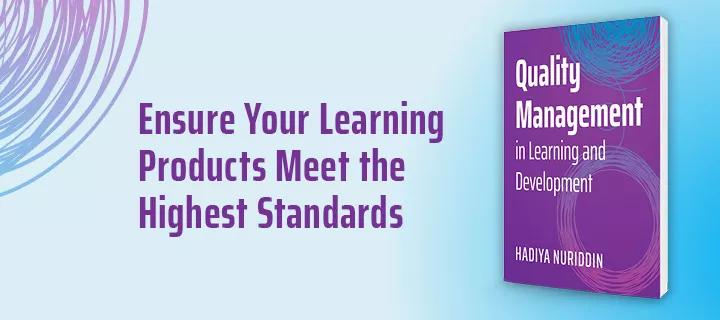ATD Blog
Every Change Needs a Champion: Quality Champions in Learning and Development
Mon Jun 24 2024

Bookmark
Suppose you’re a dedicated, experienced learning designer who has always been passionate about quality and continuous improvement. While your team has created effective training programs, you’ve noticed inconsistencies in processes and outcomes. You believe a quality management (QM) system could help, but you’re unsure if your team would embrace such a change. Despite your doubts, you have decided to champion the cause, advocating for the benefits of quality management and inspiring your colleagues to see its value.
You are a quality champion.
Developing a QM system seems daunting for many learning and development (L&D) teams. Where the journey begins depends on a variety of factors, including how you currently address quality. Quality champions lead the advocacy effort, building a strong and long-lasting bridge that helps some teams reach step one. These individuals, like you, advocate and champion the benefits and principles of quality management.
The Role of a Quality Champion
As a quality champion, you support a culture of quality and continuous improvement within L&D teams. You play a vital role in highlighting the significance and advantages of quality management before, during, and after the system is designed.
Through your advocacy, you promote the value and necessity of QM systems to team members, ensuring everyone understands how quality contributes to the organization’s success. By inspiring and motivating your colleagues to seek ongoing improvements in processes and outcomes, you encourage innovation to overcome the challenges of guideline compliance.
You also increase awareness and understanding of QM principles. While you may not directly implement or manage systems, you provide essential support and encouragement for quality improvement initiatives. You act as a sounding board and a source of motivation for the project leaders, ensuring that quality remains a fundamental aspect of the L&D workflow.
You aid your team members by inspiring and motivating them to embrace quality improvement initiatives. You boost morale and commitment to excellence by highlighting the importance of quality and its positive impact on the organization and its employees—a motivation crucial to maintaining high engagement and dedication within the team.
Another advantage you provide is promoting efficient resource use. By advocating for streamlined processes and best practices, you help optimize resources, reduce waste, and increase the team’s overall efficiency.
Benefits of Being a Quality Champion
Becoming a quality champion offers you numerous personal and professional benefits. It enhances your leadership and advocacy skills and contributes to your personal and professional growth. You may also gain recognition from peers and leadership for your efforts in promoting quality initiatives, which increases your visibility within the organization. This expertise enhances your current position and develops your professional portfolio, strengthening your candidacy for future career opportunities.
You also have the chance to connect with other professionals inside and outside the organization who are passionate about quality and improvement. This networking opportunity can lead to valuable collaborations and the sharing of best practices, further enhancing your understanding and effectiveness in your role.
Become an L&D Quality Champion
In some cases, champions are chosen or appointed, but in most cases, champions can appoint themselves. Becoming a quality champion is driven by a passion for quality, a commitment to continuous improvement, and the ability to inspire and influence others. Here are key steps to becoming a quality champion within an L&D team:
Understand learning design and development processes. To be an effective quality champion in L&D, you must understand these processes as your organization practices them. Use this knowledge to advocate for improvements that are grounded in managing quality and sound instructional design principles.
Develop an understanding of quality management. Start by gaining a basic understanding of QM principles, methodologies, and best practices. For instance, read a few articles on Six Sigma or ISO 9001 standards. Share insights from these readings with your team to highlight the importance of these principles in managing quality.
Embrace continuous learning. Quality champions are lifelong learners. Stay updated with the latest trends, tools, and techniques in QM by attending free webinars or reading recent industry articles on the topic. Discuss relevant points with your team during a casual conversation to encourage continuous learning and managing quality processes.
Demonstrate commitment to quality. Show your dedication to quality in your daily interactions. For example, when discussing new projects or initiatives, emphasize the importance of managing quality and how creating and implementing consistent processes may improve the team’s outcomes.
Cultivate strong communication skills. Effective communication is crucial. Develop the ability to articulate the importance of quality management to various stakeholders clearly. During team meetings, briefly explain how focusing on managing quality leads to better training outcomes and increased learner satisfaction.
Build relationships and collaborate. Quality champions need to work collaboratively. Engage with colleagues from other departments by having informal conversations to understand their perspectives on quality. For example, have a quick chat with a colleague from finance to discuss how managing quality training can support their goals.
Advocate for quality. Take every opportunity to advocate for QM systems. During conversations, mention the benefits of managing quality in learning programs. Share a simple success story, such as how a minor adjustment in the design process led to better engagement.
Support and mentor others. Support your colleagues by sharing your knowledge and enthusiasm for QM practices. During a team discussion, help others understand long-term benefits of managing quality and processes in training and development.
Measure and communicate results. Observe the progress and outcomes of quality advocacy to demonstrate its positive impact. Note any improvements in team attitudes or practices after you’ve championed QM principles. Share these observations with your team to reinforce the value of managing quality.
Stay Resilient and Patient
Becoming a quality champion is a gradual process that requires resilience and patience. Along the way, you will encounter challenges and setbacks, such as resistance to change or resource constraints. Stay focused on long-term goals and maintain a positive attitude to persevere through these challenges.
By becoming a QM champion, you foster a culture of excellence, encourage innovation, and ensure the efficient use of resources. Your efforts will leave a legacy, benefiting your colleagues and the broader L&D community.
For more information about quality management, check out Quality Management in Learning and Development, by Hadiya Nuriddin.
More from ATD

